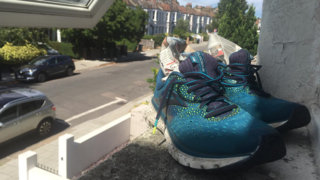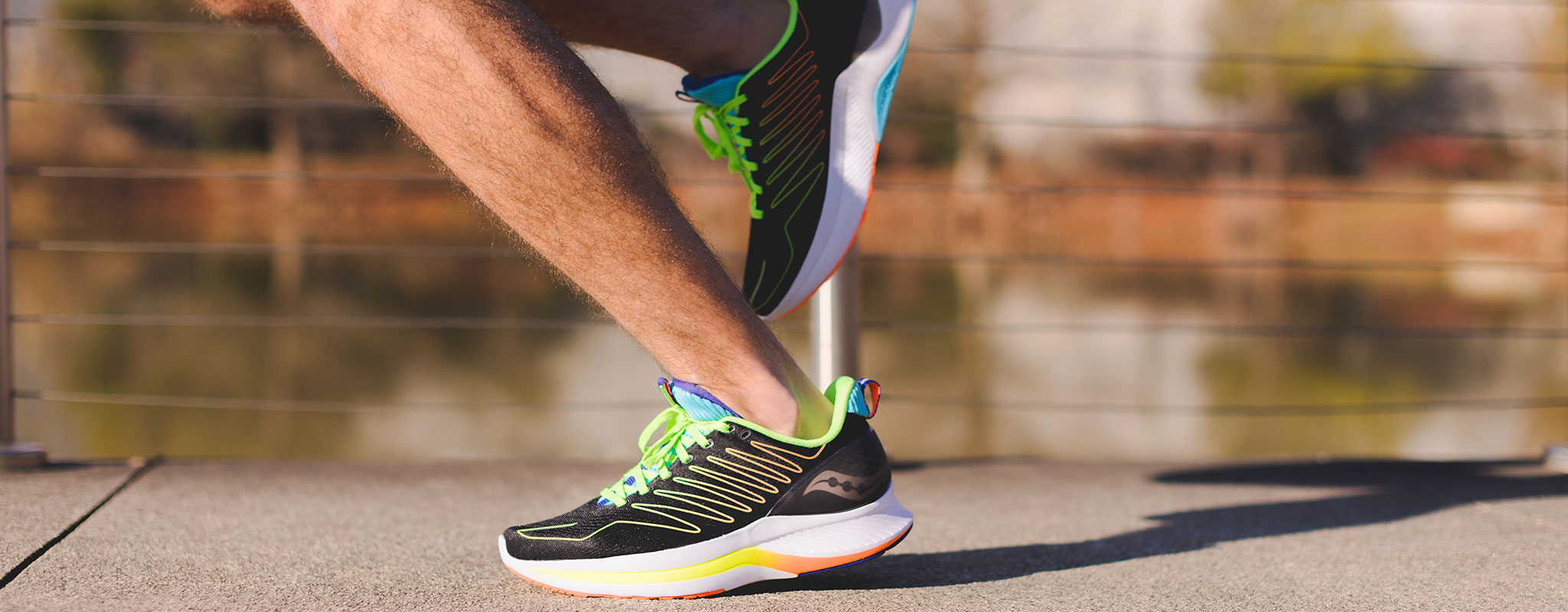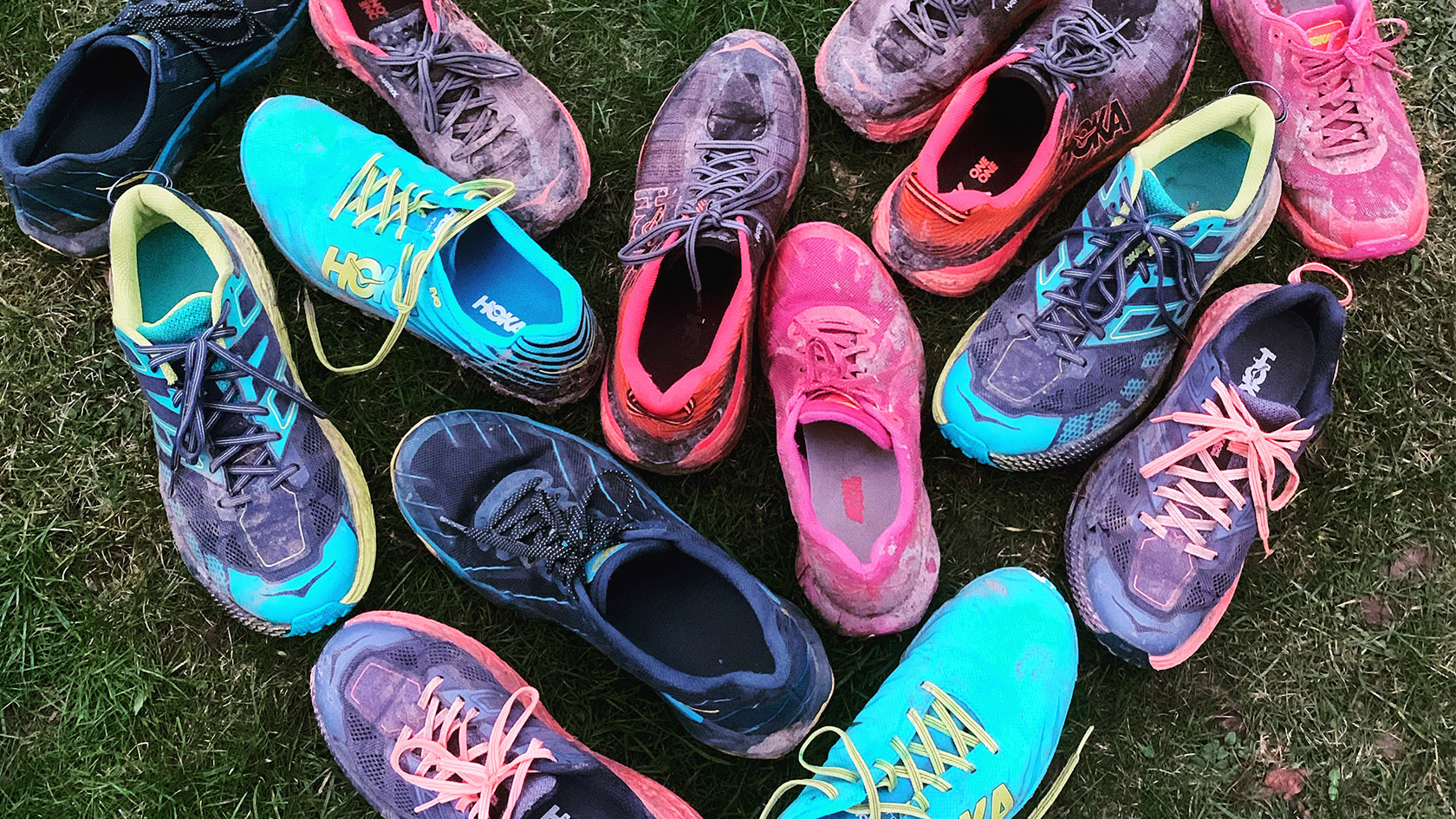Even your favourite pair of running shoes will get old and worn out as you pump the miles. Old, worn-out shoes give you a much higher chance of running injuries to your ankles, knees, and hips. Read our guide and discover the signs for when to replace your running shoes...
Why Replacing Running Shoes Matters
Let’s start with the basics. Why should you even care about replacing your running shoes? After all, they still look okay, right?
Worn-out running shoes are a silent saboteur. They might look fine on the outside, but inside, the cushioning and support could be long gone. This means:
- Less shock absorption → Your joints and muscles take more of the impact.
- Increased risk of injury → Think shin splints, plantar fasciitis, knee pain, and more.
- Reduced performance → Tired legs, sore feet, and a slower pace.
Pro Tip → If your knees, ankles, or hips start to ache after a run, your shoes might be to blame!
How Long Do Running Shoes Last
This is the million-pound question. While there’s no one-size-fits-all answer, most experts (and brands like Asics, Brooks, Salomon, and Saucony) agree on some general guidelines.
The 300–500 Mile Rule
Most standard running shoes last between 300 and 500 miles (that’s about 500–800km). Here’s how that breaks down:
- Lightweight/racing shoes → 250–300 miles
- Daily trainers → 300–500 miles
- Trail shoes → 300–500 miles (but terrain matters-see below!)
What Affects Running Shoe Lifespan?
Not all shoes (or runners) are created equal. Several factors can make your shoes wear out faster-or last a bit longer.
1. Your Running Surface
If you have sections of your run that take you off-road when in road running shoes, your shoes are more likely to wear quicker or get damaged. Try and ensure (where possible) you stick to the surface type you have bought your new shoes for and avoid rougher and hotter paths, as this will also lead to quicker wearing.
- Road running → Pavement is hard on shoes, but wear is fairly even.
- Trail running → Mud, rocks, and roots can chew up shoes quickly.
- Treadmill running → Gentler on shoes, so they may last longer.
2. Your Running Style
Let's start by saying there is no correct style of running - everyone is different. However, understanding your specific run helps to ensure you buy and wear shoes better suited to your running style, helping you avoid unnecessary injuries and enhancing your comfort and performance.
How your foot strikes the ground as you run impacts the wear of your shoes. Have you ever looked at the soles of your used running shoes? When you do, you notice areas with more wear - these help indicate your main impact zones.
If it’s under the big toe or to the side at the front of the shoe, you’re running leading with your forefoot. This is most common for sprinters and hill runners and can lead to the outer sole breaking through and exposing the midsole. If the main impact zone is in your midfoot, the same will occur with the ball of your foot. Wear in the heel is most common for long-distance road runners. This excessive heel wear, even if the rest of the shoe is fine, can mean your foot and ankle are exposed to injury as your shoe support can become reduced.
- Heel strikers → Wear out the heel first.
- Forefoot/midfoot strikers → Wear shows up at the front.
- Overpronators → May see more wear on the inside edge.
If you want to know more about your unique running style and get the right shoes for you, why not book a Gait Analysis appointment with our experts at your local Runners Need store? To learn more about our Gait Analysis service, click here.
3. Your Weight and Build
Most shoes are tailored to the 'average runner' profile, meaning if you're heavier or taller than average - your shoes will wear faster and need replacing more often. For people within this bracket, we recommend getting more supportive running shoes to ensure you're adequately protected and comfortable on all terrains.
4. Shoe Construction
- Minimalist shoes → Less cushioning, so they wear out faster.
- Max-cushion shoes → More material, but foam still breaks down over time.
5. Frequency and Intensity
- Daily runners → Shoes wear out faster.
- Occasional runners → Shoes last longer, but foam can degrade with age, too.

How Do You Know When Your Running Shoes Are Worn Out?
Tracking apps like Strava allow you to record which shoes you’ve worn for each run, so even if you’re using more than one pair, you know exactly how many miles each one has done. Otherwise, an easy alternative is to write the date you bought your shoes on the inside to use as a future guide.
However, if you don’t know how long you’ve had your shoes or how far you’ve run in them, here are some sure signs that it's time for a new pair:
- Worn Outsole → Check the tread. If it’s smooth or uneven, it’s time to replace.
- Compressed Midsole → Press the midsole foam. If it feels hard, flat, or unresponsive, cushioning is gone.
- Visible Creases → Deep creases in the foam mean it’s lost its bounce.
- Heel Counter Breakdown → If the heel feels floppy or collapsed, support is compromised.
- Blisters or Hot Spots → New blisters or sore spots often mean the shoe’s shape has changed.
- New Aches and Pains → If you’re suddenly sore after runs, check your shoes first.
- Running Feels Harder → If your stride feels less smooth or you tire more quickly, your shoes may be to blame.
Quick Test → Place your shoes on a flat surface. If they tilt to one side, the sole is worn unevenly.
How to Track Your Running Shoe Mileage
Keeping tabs on your shoe mileage is easier than ever.
1. Use a Running App → Strava, Garmin Connect, Nike Run Club, Runkeeper: All let you log which shoes you wore for each run. Set a reminder - Most apps let you set a mileage limit and will alert you when you’re due for a new pair.
2. Manual Log → Old school but effective! Write the purchase date inside your shoe or keep a notebook.
3. Shoe Rotation → If you use multiple pairs, track each one separately to avoid confusion.
How Do I Make My Running Shoes Last Longer?
Keeping your shoes on the tracks and trails isn't just great for your bank balance - it's great for the environment. The longer we wear our shoes, the longer we keep them out of landfills. Here are our top tips for keeping your running shoes running fit to help you get the most out of each pair:

1. Only Wear Your Running Shoes For Running
The more you wear your running shoes to pop to the shops or pick up the kids from school, the quicker they'll wear down. Running shoes are designed for road running, trail running, and races, so the more you wear your running shoes for activities other than running, the more empty miles you add to their count, and the quicker they’ll wear in main impact zones.
2. Always Undo and Redo Laces
Siipping your shoes on and off wears the heel down and stretches the shoe out of shape. An alternative to this is to purchase laces that don’t need to be tied (such as our range of Lock Laces) or try out a new lacing method. Having the wrong lace pattern can cause quicker wear, so make sure the way you’re laced up is right for you and try out various styles on your runs to find your match.
3. Keep Your Shoes Clean
After every run, check your shoes over and remove any stones from the tread on the outsole. If dirty, use a sponge and soapy water and air dry them, or if you’re in a rush to use them again, stuff them with newspaper.
4. Wear The Correct Socks
Shoes are protected from the outside, not the inside, so if your socks aren’t meant for running or aren’t good quality - they cause damage to the inner material. Lower-cut socks can also prematurely wear out the inside of your shoes, so wearing longer socks when running is recommended for your shoe's longevity.
Read our guide to buying the perfect running socks here.
5. Rotate Multiple Pairs
As we’ve already mentioned, there are numerous benefits to having two pairs of shoes on the go, including how often you need to replace your shoes.
On top of using a new pair to check the wear of an old one, a second pair means you can select the best shoes for that day’s run. If one pair gets wet, you can swap to the other pair of shoes for the next day's run and allow the previous pair to properly air-dry. In addition, your shoes won’t dictate your running style and will make transitioning into the next pair easier.
Still Got Questions? Ask Our Experts!
If you've still got questions about replacing your old running shoes or want to get to know your feet and running style a little better, we recommend popping into your local Runners Need store and chatting with our run experts.
Our expert staff are always on hand to help give you and your run a helping hand and are happy to help examine your shoes to see how they're faring, what you can do to keep them going, and when they need replacing. While you're in-store, we also recommend booking a Gait Analysis appointment and 3D Foot Scan to ensure you're always fitted with the right pair of shoes for your running style.

FAQs
Most running shoes are designed to last between 300 and 500 miles (about 500 to 800 kilometres). Lightweight or racing shoes may wear out sooner, often around 250 to 300 miles
- Check the outsole for smooth or uneven wear.
- Press the midsole-if it feels hard or flat, cushioning is gone.
- Look for new aches, pains, or blisters.
You risk injury-think shin splints, plantar fasciitis, knee pain, and more. Plus, your runs will feel less comfortable and more tiring.
Absolutely. Rotating shoes gives the cushioning time to recover and can extend the life of each pair. It’s also a great excuse to own more than one pair!
Not always. Durability depends more on construction, materials, and how you use them than on price alone.
- Only use them for running.
- Clean them regularly and let them air dry.
- Untie laces before taking them off.
- Store in a cool, dry place.
Yes. Lightweight shoes made with thinner materials tend to wear out faster, while more robust, cushioned models generally last longer within the 300–500 mile range.
Look for signs such as worn-out treads, compressed or unresponsive midsoles, new aches or pains, and visible creasing or breakdown in the shoe’s structure.
Yes. Even if you haven’t hit the mileage target, it’s recommended to replace your running shoes every six months if you run occasionally, as the materials can break down over time.
Use a running app, keep a manual log, or write the purchase date inside your shoe to help you remember when it’s time for a replacement.
Related Articles










